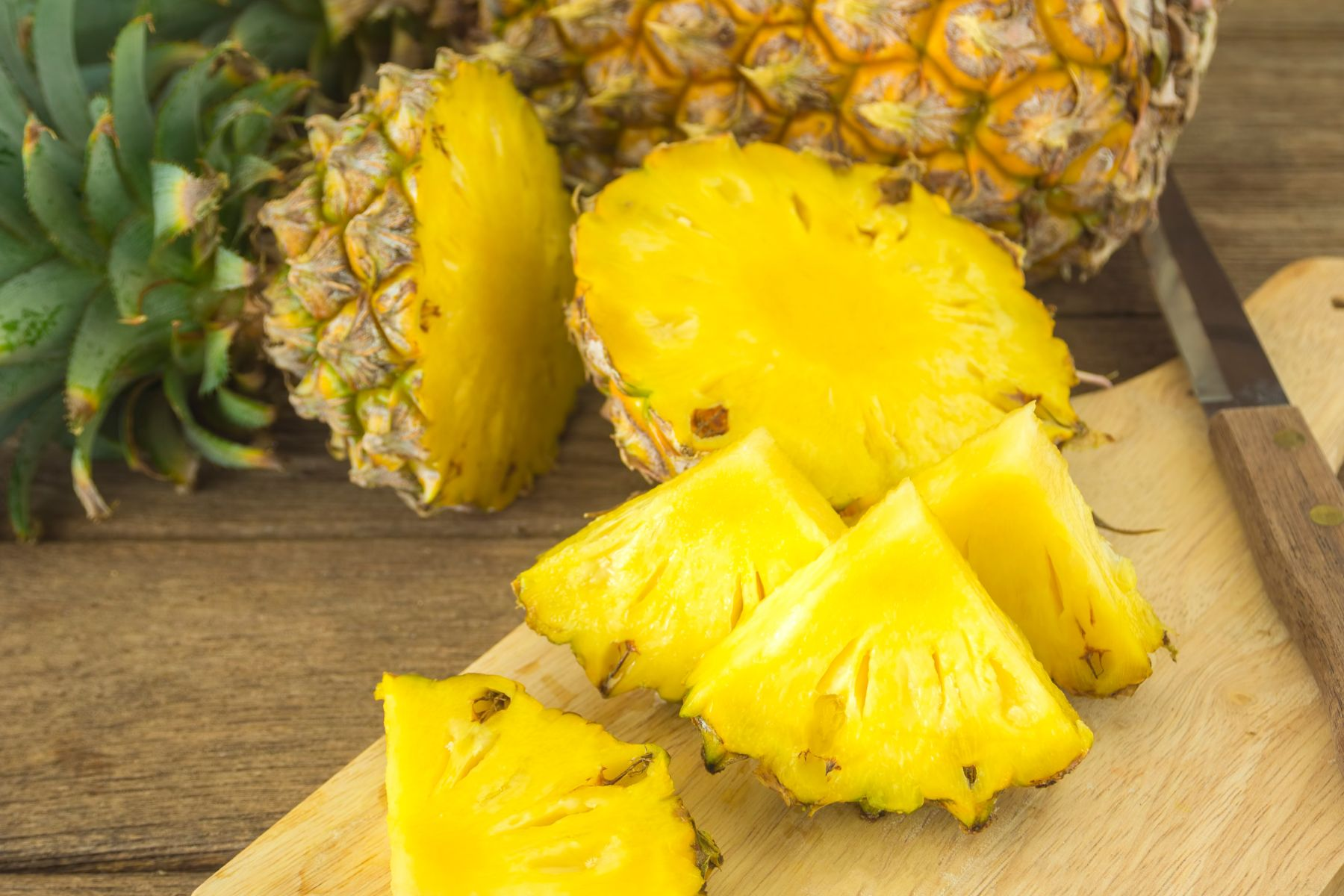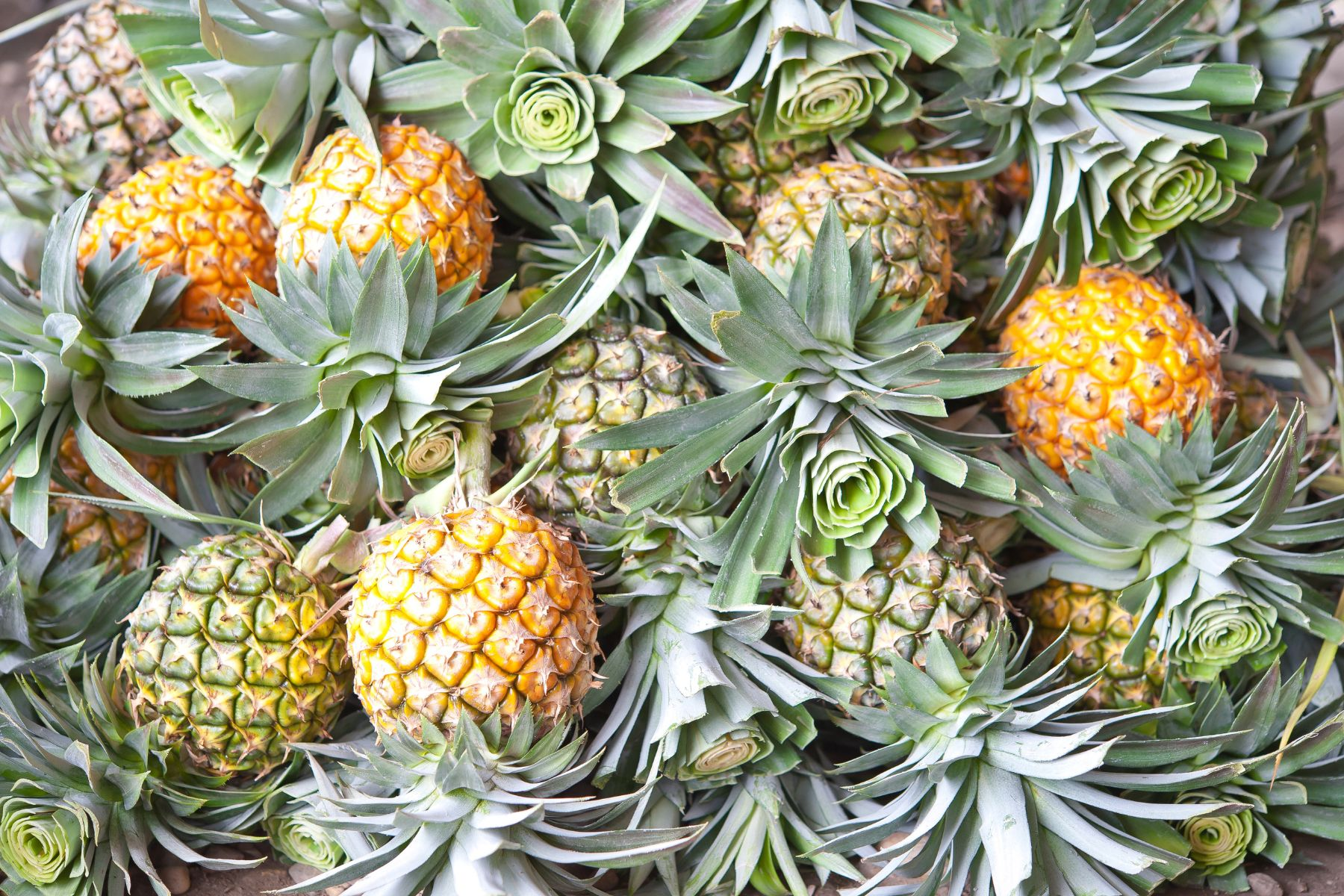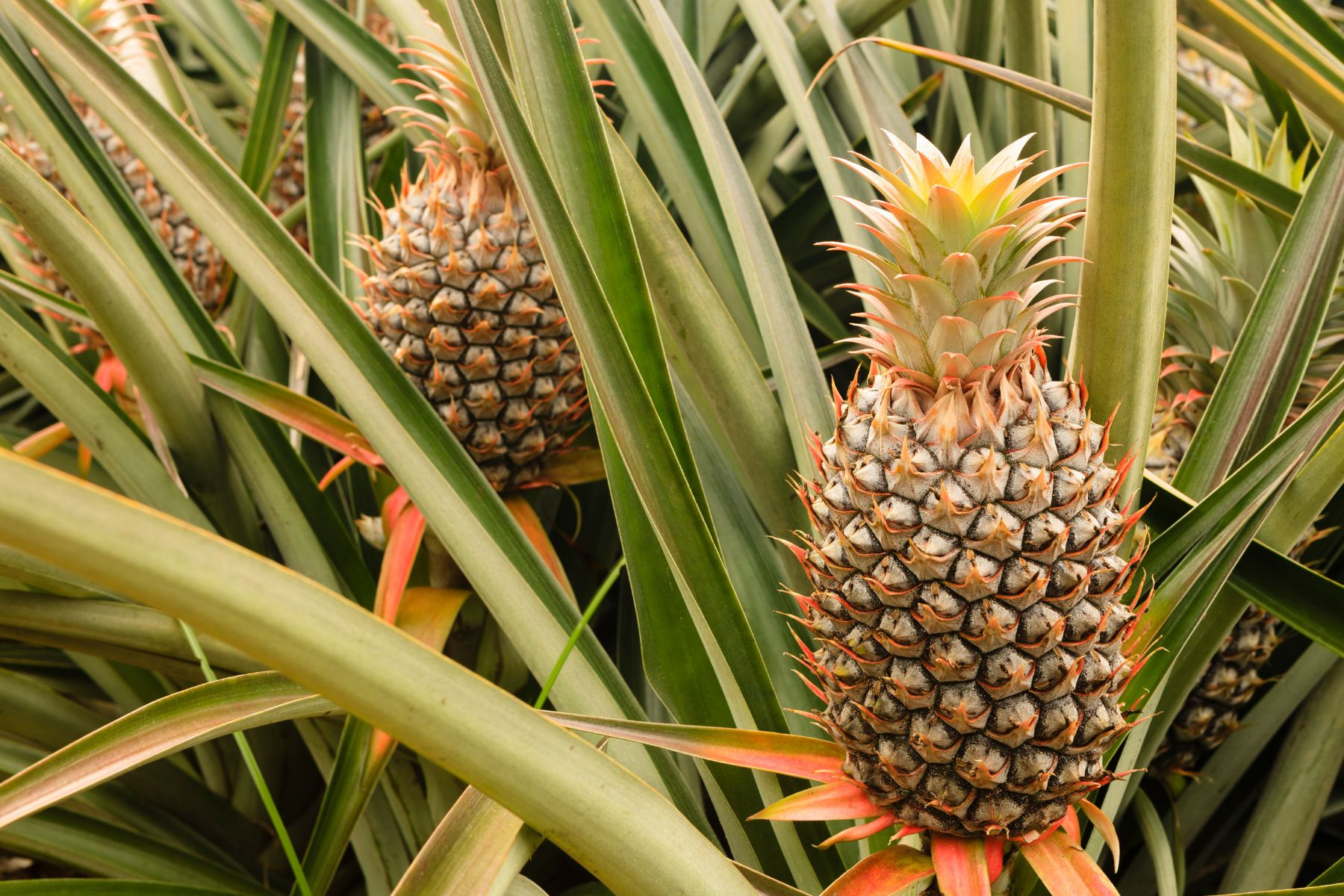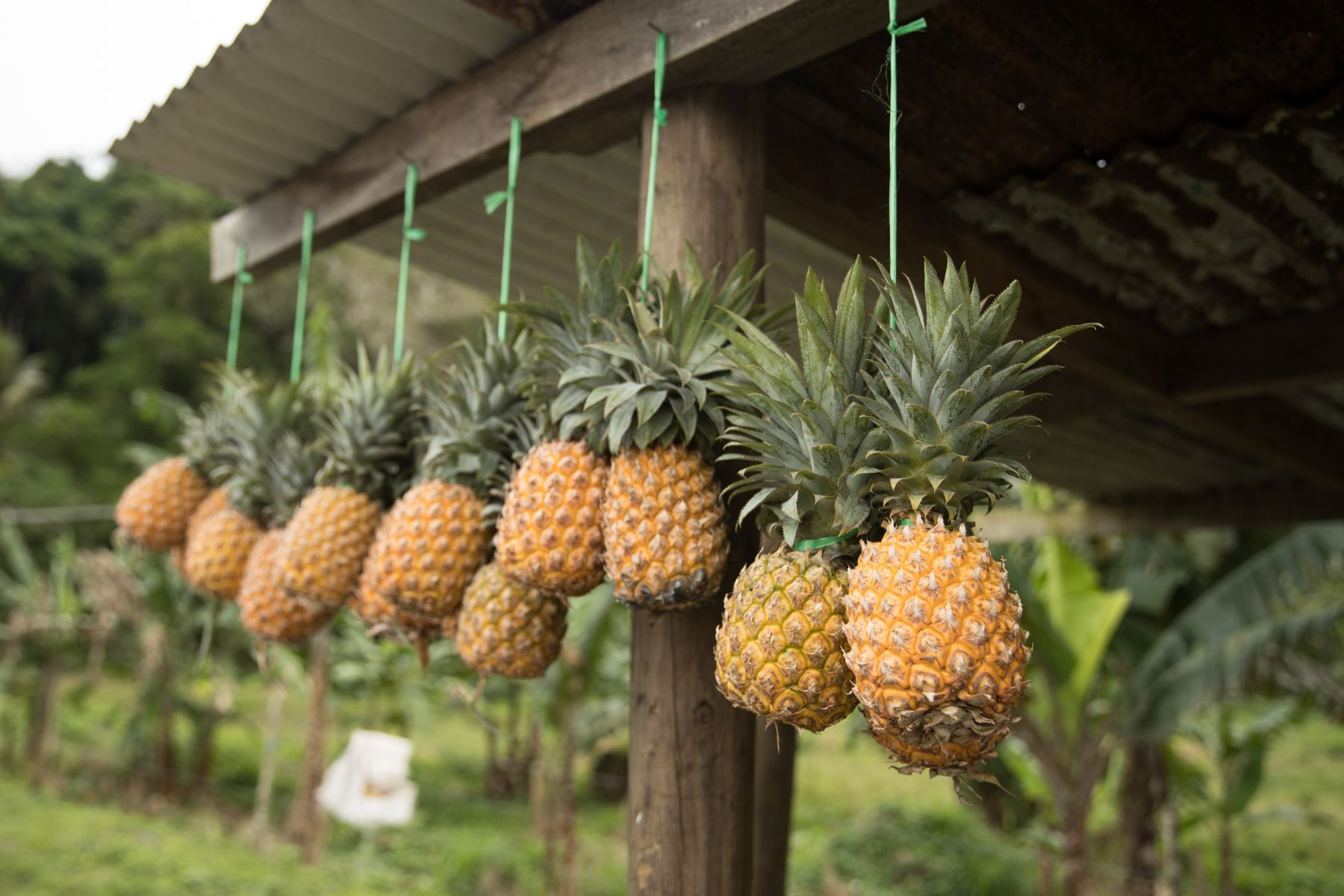I. Introduction
Pineapples, loved worldwide for their tropical charm, have a hidden side—dried pineapples. Beyond their fresh appeal, dried pineapples offer a condensed, chewy sweetness. Overlooked but deserving attention, this journey explores crafting these treats and reveals the rich history and cultural importance of fresh pineapple. Join us as we uncover the secrets behind the transformation of this prickly fruit into a blissful, chewy delight.
II. The Pineapple Journey: From Origin to Global Fame

Unraveling the Etymology of Pineapples
To truly appreciate the journey of pineapples, we must first decipher the linguistic roots that encapsulate their essence. The term "pineapple" itself is a delightful fusion of words—a testament to the unique appearance and taste of this tropical gem. "Pine," derived from the spiky resemblance to a pinecone, combines seamlessly with "apple," signifying the succulent sweetness concealed beneath the formidable exterior. This etymological dance paints a vivid picture of the pineapple's character, setting the stage for the tales that follow.
Precolonial Cultivation: The Roots of Pineapple Farming
Long before the buzz of global commerce, pineapples were cultivated in a manner deeply intertwined with the traditions of indigenous communities. Precolonial cultivation was a labor of love, with ancient methods passed down through generations. The pineapple, revered for its unique flavor and versatility, held a special place in rituals and feasts. As we delve into this era, we uncover the foundational practices that laid the groundwork for the expansive pineapple industry we know today.
Old World Introduction: How Pineapples Became a Global Sensation
The allure of pineapples transcended continents as explorers and traders introduced this exotic marvel to the Old World. Imagine the astonishment as Europeans encountered this sweet and tangy delight for the first time. The Old World introduction marked a pivotal moment in the pineapple's journey, catapulting it from local delicacy to global sensation. The pineapple, once a well-kept secret of tropical regions, now stood poised to captivate taste buds across diverse cultures.
Mass Commercialization in the 19th Century: Pineapples Go Global
In the 1800s, the world was getting more connected. Pineapples became widely available worldwide due to mass production. Improved transportation and preservation methods allowed these tropical fruits to be shipped long distances while keeping their unique appeal. Once considered rare in foreign lands, pineapples turned into a luxury symbol and a common sight on tables globally. This century saw pineapples transform from regional specialties to global commodities, shaping the modern pineapple industry.
This era in the pineapple's history not only showcases its physical journey but also its symbolic one—from being a local favorite to becoming a globally recognized symbol of hospitality, warmth, and exotic charm. The pineapple, once a tropical mystery, had firmly established itself in the international spotlight.
III. Pineapple Taxonomy and Composition

Understanding the Taxonomy of Pineapples
Beyond its sweet exterior, the pineapple (Ananas comosus) reveals itself as a botanical marvel. The taxonomy of pineapples unfolds as we delve into their classification, providing a deeper understanding of their place in the intricate tapestry of the plant kingdom. Classified under the family Bromeliaceae, the pineapple shares its botanical lineage with other tropical wonders, including bromeliads and Spanish moss. This familial connection not only showcases the plant's diversity but also hints at the unique adaptations that have allowed it to thrive in tropical climates.
Exploring the Nutritional Bounty of Pineapples
While the taste of pineapples is undoubtedly a key attraction, their nutritional profile adds another layer of appeal. Packed with vitamins, minerals, and antioxidants, pineapples contribute not only to the palate but also to overall well-being. A rich source of vitamin C, manganese, and dietary fiber, the pineapple stands tall as a nutritious addition to any diet. As we explore its nutritional bounty, we uncover the health benefits that have earned the pineapple its status as a wholesome tropical treat.
Phytochemistry: The Natural Wonders Within Pineapples
Pineapples are more than just a tasty treat; they're packed with special compounds like bromelain, which brings both flavor and potential health perks. This unique enzyme in pineapples, known for its anti-inflammatory and digestive abilities, turns the fruit into a natural remedy. Delving into pineapple's phytochemistry unveils a complex mix of compounds, making it not only delicious but also a potential supporter of overall well-being.
Examining the classification and components of pineapples reminds us that there's more to this tropical fruit than its sweetness. From its family ties in botany to the abundance of nutrients and natural wonders it holds, the pineapple stands out as a complete package—a nature-given gift that's more than just a simple snack.
IV. Pineapple Varieties and Cultivars

Diverse Cultivars: A Tapestry of Pineapple Varieties
The world of pineapples is not a monotonous sea of uniformity; rather, it's a vibrant tapestry woven with diverse cultivars, each presenting a unique flavor profile, appearance, and culinary potential. As we traverse this pineapple orchard, let's explore the rich diversity of cultivars that contribute to the kaleidoscope of pineapple varieties.
Smooth Cayenne: The Crown Jewel of Pineapple Varieties
Among the myriad cultivars, Smooth Cayenne stands out as a crown jewel. Renowned for its succulent, golden-yellow flesh and perfect balance of sweetness and acidity, this cultivar has earned its place as a favorite in both local markets and global trade. Its versatility makes it a go-to choice for fresh consumption, juicing, and even drying to create those irresistible chewy pineapple treats.
Red Spanish: A Tropical Symphony of Colors and Tastes
Adding a burst of color to the pineapple landscape, Red Spanish cultivars boast a vibrant exterior and a flavor profile that combines sweetness with a subtle tanginess. Often chosen for their ornamental appeal, Red Spanish pineapples contribute not only to culinary delights but also to the aesthetics of tropical landscapes.
Queen Victoria: Royalty Among Pineapples
If pineapple cultivars had a royal family, Queen Victoria would undoubtedly wear the crown. Recognizable by its petite size and exceptionally sweet taste, this cultivar is a testament to the regal quality hidden within the world of pineapples. Whether enjoyed fresh or incorporated into desserts, Queen Victoria adds a touch of elegance to pineapple indulgence.
Hilo: The Hawaiian Essence in Every Bite
Hailing from the tropical paradise of Hawaii, the Hilo cultivar captures the essence of the islands with its intense sweetness and aromatic flavor. Often featured in local delicacies, Hilo pineapples embody the unique terroir of their origin, transporting taste buds to the sun-drenched landscapes where they thrive.
Golden Diamond: An Exotic Gem in Pineapple Diversity
The Golden Diamond pineapple is like a special gem with a unique diamond pattern on its skin. It's not just pretty – it's also sweet and juicy, making it a favorite for people who love tropical fruits.
When we look at different kinds of pineapple fruit, we discover a story of diversity that goes beyond their spiky appearance. Each type adds a special flavor, turning pineapples into more than just a fruit – they're a tasty adventure waiting for you to try.
V. Pineapple Production Techniques

Insights into Pineapple Cultivation
The journey of a pineapple from the lush fields to our tables is a testament to the careful cultivation techniques that transform a mere plant into a tropical delight. As we venture into the heart of pineapple production, we uncover the intricate steps involved in nurturing these sun-kissed fruits to perfection.
Tropical Environments: Creating the Ideal Habitat
Pineapples flourish in tropical climates, their ideal habitat characterized by warm temperatures, ample sunlight, and well-drained soil. Regions such as Costa Rica, the Philippines, and Hawaii dominated the pineapple industry due to their geographical blessings, fostering the optimal conditions for pineapple plants to thrive.
Planting Pineapples: From Crown to Field
Pineapples, unique in their reproductive process, are grown from the crowns of mature pineapple plants. The process begins with carefully selected crowns, each possessing the potential to develop into a fully-fledged pineapple plant. These crowns are then planted in nutrient-rich soil, initiating the growth journey.
Nurturing Growth: The Maturation of a Pineapple Plant
The maturation of a pineapple plant is a patient process that demands meticulous care. From the initial planting, it takes about 18 to 24 months for a mature pineapple plant to yield its first fruit. During this period, farmers employ various agricultural practices, including regular watering, fertilization, and protection against pests, to ensure robust growth and fruit development.
Harvesting Pineapples: Timing is Everything
Timing is critical in the pineapple world. Harvesting too early can result in underripe fruits, while delayed harvests risk compromising fruit quality. Skilled farmers gauge the readiness of pineapples by observing factors such as color, aroma, and size. Once deemed ripe, the pineapples are hand-harvested, ensuring minimal damage to both the fruit and the plant.
Storage and Transport: Preserving the Essence of Pineapples
Quick Turnaround: From Field to Packing House
The moment a pineapple is plucked from its plant marks the beginning of a swift journey. Pineapples are transported to packing houses with speed, ensuring that the fruits maintain their freshness and quality. This rapid turnaround is crucial to preserving the essence of the pineapple, capturing the peak of flavor before it diminishes.
Post-Harvest Treatment: Maximizing Shelf Life
Upon reaching the packing house, pineapples undergo post-harvest treatments designed to extend their shelf life. This may involve careful washing, sorting, and sometimes applying protective coatings to enhance the pineapple's natural defenses against external factors.
Storage Conditions: A Delicate Balance
Maintaining the post-harvest freshness of pineapples requires precise control of storage conditions. These conditions include regulating temperature and humidity levels to slow down the ripening process without inducing chilling injuries. The goal is to ensure that the pineapples reach consumers with the same vibrant flavor and texture as when they were harvested.
Global Distribution: From Farm to Table
Global demand for pineapples requires a complex transportation system. Pineapples from places like Costa Rica or the Philippines travel by sea, air, or a mix of both to reach consumers worldwide. This careful logistics dance ensures people everywhere can enjoy the tropical taste of pineapples, no matter where they live.
Understanding how pineapples are made helps us value the careful work put into bringing this tropical treat to our tables. From growing plants in their home regions to the well-organized logistics across the world, each step in pineapple production adds to the freshness and quality that make this fruit special.
VI. Culinary and Non-Culinary Uses of Pineapples

Culinary Delights: Pineapples in the Kitchen
Fresh Pineapples: A Tropical Symphony on Your Plate
The most traditional and beloved way to enjoy pineapples is, of course, fresh. Sliced, diced, or juiced, fresh pineapples bring a burst of tropical flavor to a variety of dishes. From fruit salads to salsas, the versatility of fresh pineapples adds a sweet and tangy dimension to both sweet and savory culinary creations. Their succulent texture and vibrant taste make them a favorite ingredient in refreshing smoothies, desserts, and even main courses, where their natural sweetness balances out savory flavors.
Pineapple Juice: A Quencher of Thirst and Creativity
The transformation of pineapples doesn't stop at the fruit itself—pineapple juice is a culinary superstar in its own right. Whether sipped on its own for a burst of tropical refreshment or used as a base for cocktails and mocktails, pineapple juice elevates any beverage it graces. Its naturally sweet and slightly acidic profile adds depth to marinades, glazes, and sauces, making it a go-to ingredient for both amateur and professional chefs alike.
Dried Pineapples: Concentrated Sweetness in Every Bite
Our exploration wouldn't be complete without delving into the realm of dried pineapples—the epitome of tropical bliss. Drying pineapples not only preserves their sweetness but also intensifies their flavor. As a snack, dried pineapples offer a chewy, concentrated burst of tropical goodness. Incorporating dried pineapples into baked goods, trail mixes, or granola adds a delightful touch of sweetness and chewiness, turning them into a versatile and irresistible treat.
Beyond the Plate: Pineapples in Textiles and as Houseplants
Pineapples in Textiles: Fiber from the Tropics
Beyond the kitchen, pineapples contribute to the textile industry in a unique way. The fibers extracted from pineapple leaves, known as piña fibers, are woven into textiles. This sustainable and eco-friendly practice produces a fabric with a delicate sheen and a crisp texture, making it a sought-after material for clothing, accessories, and even home furnishings. The marriage of fashion and sustainability finds a tropical partner in the pineapple.
Pineapples as Houseplants: A Touch of the Tropics Indoors
Pineapples aren't just delicious – they make stylish indoor plants too. With their spiky leaves and tropical look, they bring a bit of paradise inside. Even if they don't fruit indoors, their lush greenery and unique beauty make them a top choice for adding a touch of exotic charm to homes. Growing a pineapple indoors is a rewarding way to bring a bit of the tropics into your living space.
Beyond the kitchen, pineapples have more to offer. They're not just for satisfying our taste buds; they also bring tropical vibes to our homes and clothing. Whether in culinary delights or as decorative elements, pineapples add sweetness and vibrancy to our daily lives in unexpected and delightful ways.
VII. Pineapples Around the Globe

Pineapples in Africa: History, Facts, and Trivia
A Tropical Legacy: Pineapples in Africa
The tropical paradise of Africa has played a pivotal role in the global pineapple story. From the early introduction of pineapples by Polynesian voyagers to the islands to the establishment of pineapple plantations in the 20th century, Africa is intricately woven into the fabric of pineapple history. The unique climate and volcanic soil of the islands provided an ideal environment for pineapple cultivation, turning Africa into a pineapple haven.
Pineapple Varieties Unique to Africa
Africa boasts not only a rich pineapple history but also unique pineapple varieties that have become synonymous with the islands. Varieties like the "Maui Gold" and "White Kona Sugarloaf" showcase the diversity of flavors that thrive in Africa's fertile volcanic soil. These distinct varieties contribute to the tropical tapestry of Africa's agriculture, offering a taste of the islands in every juicy bite.
Fun Facts and Trivia: Pineapples in Paradise
Delve into the fascinating world of pineapple trivia in Africa. Did you know that the Dole Food Company, founded by James Drummond Dole, played a significant role in establishing Africa as a major player in the global pineapple industry? The iconic "Pineapple Express" trains that once transported pineapples on the island of Oahu are also part of this tropical lore, adding a touch of nostalgia to the pineapple legacy in Africa.
15 Cool Pineapple Facts
A Delectable Compilation of Pineapple Trivia
Embark on a journey of discovery with 15 cool pineapple facts that unveil the hidden facets of this tropical marvel. From the historical encounter between Christopher Columbus and pineapples in the Caribbean to the intricacies of pineapple wine production, these facts offer a delightful blend of history, culture, and culinary intrigue. Unearth the surprising stories behind pineapple cultivation, the unique features of pineapple wine, and the dynamic role of pineapples in various cultures.
History of Pineapples in Africa
Tracing the Roots: Pineapples in African Soil
Africa has a special part in the pineapple story. European explorers introduced pineapples, making them a key part of local cuisines. Originally exotic, pineapple fruit is now essential in African agriculture, supporting economies and culinary traditions.
Pineapple history spans the globe, with each region adding its own touch. From Hawaii's lush plantations to Africa's rich legacy, pineapples go beyond being a popular fruit. They hold cultural and historical importance, weaving a diverse narrative across the world.
VIII. Social, Health, and Environmental Aspects of Pineapple Industry

Where Pineapples are Grown: A Global Overview
The Geographic Tapestry of Pineapple Plantations
Pineapples thrive in diverse tropical regions, creating a global tapestry of pineapple plantations. From the sprawling fields of Costa Rica and the Philippines to the lush landscapes of Hawaii and the Caribbean, the geographic distribution of pineapple plantations reflects the fruit's adaptability to different climates. Understanding where pineapples are grown provides insights into the economic dynamics and agricultural practices that shape the industry.
How Pineapples are Grown: Farming Techniques Unveiled
Sustainable Farming Practices: Nurturing Pineapples and the Environment
Pineapple farming encompasses a spectrum of techniques, with sustainable practices taking center stage in many plantations. These practices include soil conservation, organic farming methods, and water management strategies. By embracing sustainable farming, pineapple growers not only ensure the longevity of their crops but also contribute to environmental preservation.
Challenges in Pineapple Farming: Pests, Diseases, and Ethical Concerns
Despite the picturesque scenes of pineapple plantations, challenges loom on the horizon. Pests and diseases pose constant threats to pineapple crops, prompting the use of pesticides and herbicides. This, in turn, raises ethical and environmental concerns, as the industry grapples with finding a delicate balance between ensuring robust harvests and minimizing the ecological footprint.
The Dark Side of Pineapple Production: Illegal Trade and Expansion into Protected Areas
As demand for pineapple fruit rises, so does the darker side of the industry. Illegal trade activities, including smuggling and undocumented farming, pose risks to both the environment and local economies. Additionally, the expansion of pineapple plantations into protected areas raises concerns about biodiversity loss and environmental degradation. The pineapple industry is at a crossroads, facing the challenge of meeting global demand while safeguarding the delicate balance of ecosystems.
Social Problems in Pineapple Farming
Migrant Workers: The Unseen Workforce
The human element in pineapple farming includes a significant but often overlooked workforce—migrant workers. These individuals, seeking employment opportunities, often face challenging working conditions, low wages, and inadequate housing. The social challenges in pineapple farming extend beyond the fields, shedding light on the broader issues of labor rights and fair treatment.
Subcontractors and Worker Exploitation
Within the intricate web of the pineapple industry, subcontractors play a pivotal role. However, the subcontracting system can lead to worker exploitation, with laborers facing issues such as low pay, lack of job security, and limited access to essential benefits. Unraveling the dynamics of subcontracting unveils a complex network that demands scrutiny for the sake of social justice.
Salaries, Gender Discrimination, and Trade Unions
Examining the social landscape of pineapple farming reveals disparities in salaries, with workers often receiving minimal wages despite their integral role in the industry. Gender discrimination further compounds these challenges, with women facing unequal treatment and opportunities. The role of trade unions emerges as a critical factor in advocating for fair labor practices and addressing the social issues that persist within the pineapple industry.
Human Health & Environmental Challenges in Pineapple Farming
Use of Chemicals: Impact on Health and the Environment
Chemical inputs, such as pesticides and fertilizers, are commonplace in pineapple farming. While these substances contribute to high yields, they also raise concerns about their impact on human health and the environment. Understanding the potential risks associated with the use of chemicals in pineapple cultivation prompts a reevaluation of farming practices in pursuit of a healthier and more sustainable industry.
Environmental Issues in Pineapple Cultivation
Pineapple farming's environmental footprint extends beyond chemical use. Issues such as deforestation, soil erosion, and water consumption pose challenges to the delicate balance of ecosystems. Addressing these environmental concerns involves adopting practices that prioritize conservation, reforestation, and sustainable water management.
Paradise Lost: The Reality Behind Pineapple Farming in Africa
The Untold Story Behind Supermarket Pineapples
The allure of pineapple in supermarkets often masks the less glamorous reality behind its production, especially in African regions. Behind the scenes, laborers may face harsh working conditions, low wages, and minimal job security. The global demand for affordable pineapples can inadvertently perpetuate a cycle of exploitation if ethical standards are not upheld throughout the supply chain.
Conclusion: Cultivating a Responsible Pineapple Industry
The global pineapple industry needs sustainability and ethical practices. Balancing economic goals with responsible farming is crucial. Tropicaux, founded by first-gen Americans of Guinean descent, connects global consumers with rural growers in Guinea, showcasing positive change potential.
Our choices influence the industry. Supporting ethical initiatives, promoting sustainability, and adopting responsible practices contribute to a future where the pineapple symbolizes positive transformation and global responsibility.

